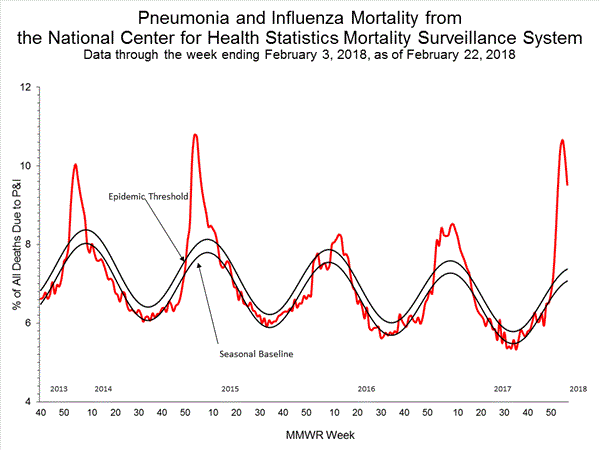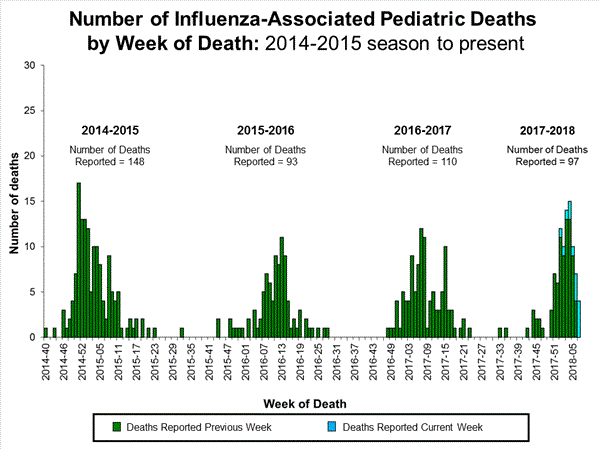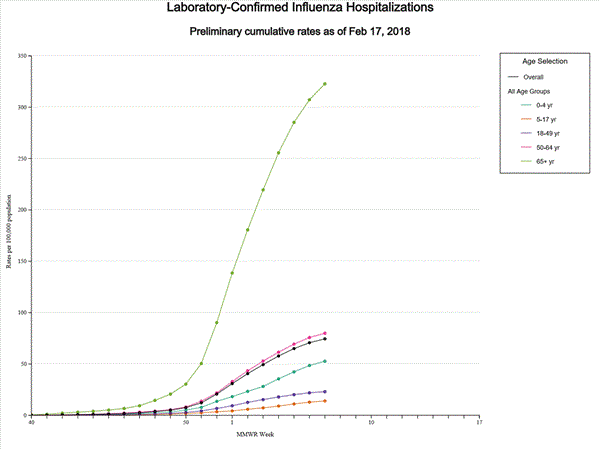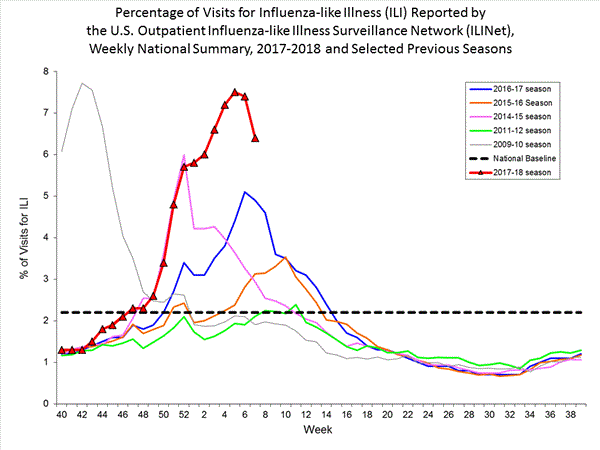Archive for February, 2018
Japan: a potentially groundbreaking new drug (Xofluza) that can kill the flu virus in just one day has won regulatory approval
Saturday, February 24th, 2018“…….Xofluza….could soon prove to be a significant competitor to Swiss drug giant Roche’s Tamiflu…. But it could also take until at least 2019 for Xofluza to reach the U.S. market. Xofluza ….requires far fewer doses—just a single pill, in fact, compared with the five-day, two-doses-per-day regimen required by Tamiflu…..Xofluza was able to kill off the flu virus in 24 hours….”
Chicken Salad & The Case of the Multistate Outbreak of Salmonella Typhimurium
Saturday, February 24th, 2018- CDC recommends people do not eat recalled chicken salad sold at Fareway grocery stores. Throw it away or return it to the place of purchase.
- On February 21, 2018, Triple T Specialty Meats, Inc. recalled all chicken salad produced from January 2, 2018 to February 7, 2018.
- The recalled chicken salad was sold in containers of various weights from the deli at Fareway grocery stores in Illinois, Iowa, Minnesota, Nebraska, and South Dakota from January 4, 2018 to February 9, 2018.
- Even if some of the chicken salad was eaten or served and no one got sick, throw the rest of it away. Put it in a sealed bag in the trash so that children, pets, and other animals can’t eat it.
- Wash and sanitize countertops as well as drawers or shelves in refrigerators or freezers where recalled chicken salad was stored.
- If you don’t remember the date when you purchased chicken salad from Fareway, don’t eat it. Throw it away or return it to the place of purchase.

- CDC, public health and regulatory officials in several states, and the U.S. Department of Agriculture’s Food Safety and Inspection Service are investigating a multistate outbreak of Salmonella Typhimurium infections.
- Epidemiologic and laboratory evidence indicates that chicken salad produced by Triple T Specialty Meats, Inc. and sold at Fareway grocery stores is the likely source of this multistate outbreak.
- Sixty-five people infected with the outbreak strain of Salmonella Typhimurium have been reported from five states.
- Twenty-eight hospitalizations have been reported.
- No deaths have been reported.
- This investigation is ongoing. CDC will provide updates when more information is available.
![People infected with the outbreak strain of Salmonella I 4,[5],12:b:-, by state of residence, as of February 16, 2018](https://www.cdc.gov/salmonella/typhimurium-02-18/images/map/big-map-2-21-18.jpg)
2017-2018 Influenza Season Week 7 ending February 17, 2018
Saturday, February 24th, 2018Synopsis:
During week 7 (February 11-17, 2018), influenza activity remained elevated in the United States.
- Viral Surveillance: The most frequently identified influenza virus subtype reported by public health laboratories during week 7 was influenza A(H3). The percentage of respiratory specimens testing positive for influenza in clinical laboratories remained elevated.
- Pneumonia and Influenza Mortality: The proportion of deaths attributed to pneumonia and influenza (P&I) was above the system-specific epidemic threshold in the National Center for Health Statistics (NCHS) Mortality Surveillance System.
- Influenza-associated Pediatric Deaths: Thirteen influenza-associated pediatric deaths were reported.
- Influenza-associated Hospitalizations: A cumulative rate of 74.5 laboratory-confirmed influenza-associated hospitalizations per 100,000 population was reported.
- Outpatient Illness Surveillance:The proportion of outpatient visits for influenza-like illness (ILI) was 6.4%, which is above the national baseline of 2.2%. All 10 regions reported ILI at or above region-specific baseline levels. New York City, the District of Columbia, Puerto Rico and 39 states experienced high ILI activity; five states experienced moderate ILI activity; three states experienced low ILI activity; and three states experienced minimal ILI activity.
- Geographic Spread of Influenza:The geographic spread of influenza in Puerto Rico and 48 states was reported as widespread; the District of Columbia, Guam and two states reported local activity; and the U.S. Virgin Islands reported no activity.

The incidence of TB among adolescents and young adults around the world
Friday, February 23rd, 2018WHO: Recommended composition of influenza virus vaccines for use in the 2018-2019 northern hemisphere influenza season
Friday, February 23rd, 2018Recommended composition of influenza virus vaccines for use in the 2018-2019 northern hemisphere influenza season
22 February 2018
It is recommended that quadrivalent vaccines for use in the 2018-2019 northern hemisphere influenza season contain the following:
- an A/Michigan/45/2015 (H1N1)pdm09-like virus;
- an A/Singapore/INFIMH-16-0019/2016 (H3N2)-like virus;
- a B/Colorado/06/2017-like virus (B/Victoria/2/87 lineage); and
- a B/Phuket/3073/2013-like virus (B/Yamagata/16/88 lineage).
It is recommended that the influenza B virus component of trivalent vaccines for use in the 2018-2019 northern hemisphere influenza season be a B/Colorado/06/2017-like virus of the B/Victoria/2/87-lineage.
For more information
A new prophylactic vaccine was immunogenic and effective against multiple filoviruses, including Ebola and Marburg, in monkeys
Thursday, February 22nd, 2018A prophylactic multivalent vaccine against different filovirus species is immunogenic and provides protection from lethal infections with Ebolavirus and Marburgvirus species in non-human primates
“…..These results demonstrate that it is feasible to generate a multivalent filovirus vaccine that can protect against lethal infection by multiple members of the filovirus family.…….”
Cape Town residents have drastically lowered their water use, allowing their drought-plagued city to push back the dreaded “Day Zero” by more than 10 weeks.
Wednesday, February 21st, 2018“…..Cape Town has cut its water consumption to 523 million liters a day…..and less than half of what it was four years ago, before the drought began.….”
More evidence that flu transmission among mammals can occur by droplets as well as fine droplet nuclei.
Wednesday, February 21st, 2018Influenza update – 19 February 2018
Wednesday, February 21st, 2018
Summary
Influenza activity remained high in the temperate zone of the northern hemisphere while in the temperate zone of the southern hemisphere activity was at inter-seasonal levels. Worldwide, influenza A accounted still for the majority of influenza detections but influenza B (mostly B-Yamagata lineage) increased in recent weeks.
Up to now, the majority of countries which are in the influenza season, reported influenza- like illness reaching moderate levels in comparison with previous years, with few reaching levels exceeding those of previous years. Some countries however have reported levels of hospitalization and ICU admissions reaching or exceeding peak levels of previous influenza seasons. WHO recommends countries with current influenza activity or entering their season to adopt necessary measures for ensuring appropriate case management, compliance with infection control measures and seasonal influenza vaccination for high risk groups(see also the fact sheet given below).
- Overall, influenza virus activity remained high in the region. In Canada, influenza activity remain elevated while influenza-like illness (ILI) activity continued to increase and was above the 5-year average for this time of the year. Influenza B detections increased in recent weeks reaching equal proportion as influenza A detections. In the United States of America (USA), influenza activity remained high, with influenza A (H3N2) viruses most frequently detected followed by influenza B viruses. Hospitalization cumulative rate for influenza were reported at high levels, and above levels observed during the same period over the previous seven seasons. In both Canada and the USA, adults aged 65 years and older accounted for the majority of influenza cases and influenza-related hospitalizations. In Mexico, influenza activity decreased slightly, with influenza A(H3N2) virus predominantly detected.
- In Europe, influenza activity remained high in most countries. All seasonal influenza subtypes co-circulated across the region, but influenza B virus predominated in most countries. ILI and influenza detections increased further in most countries in Eastern and Northern Europe, and appeared to have peaked in few countries in Southwestern Europe. Influenza B detections increased in Denmark, Estonia, Norway, and Sweden. Influenza illness indicators appeared to decrease in Ireland and the United Kingdom, but influenza-related hospitalizations remain high in England.
- In Northern Africa, influenza detections remained high in Algeria, Egypt and Morocco, and continued to decrease in Tunisia. Influenza A(H1N1)pdm09 virus predominated in Algeria and Tunisia, and detections of influenza A(H1N1)pdm09 and influenza B were reported in Egypt and Morocco.
- In Western Asia, influenza activity continued to be reported across the region. In some countries of the Arabian Peninsula, influenza activity appeared to have peaked, while increased influenza A(H1N1)pdm09 detections were reported in Iraq. In Israel, influenza activity remained high with influenza B viruses predominating. Detections of influenza B-Yamagata lineage and influenza A(H1N1)pdm09 were reported in Armenia.
- In Central Asia, influenza A and B detections increased across the region in recent weeks.
- In East Asia, influenza activity remained high across the region. ILI activity appeared to decrease in Northern and Southern China but influenza detections remained elevated, with influenza B-Yamagata lineage and influenza A(H1N1)pdm09 viruses predominating. ILI consultation rate remained high in Hong Kong SAR, China, with influenza B most frequently detected. Decreased detections of influenza A(H1N1)pdm09 were reported in the Democratic People’s Republic of Korea. In Mongolia, respiratory illness indicators and influenza detections appeared to decrease whit influenza B-Yamagata lineage virus predominately detected in recent weeks. In the Republic of Korea, ILI activity decreased although influenza A(H3N2) and B virus detections remained high.
- In Southern Asia, influenza activity remained low in general. Detection of influenza A(H1N1)pdm09 and influenza A(H3N2) viruses continued to increase in Pakistan, while activity decreased in the Islamic Republic of Iran.
- In South East Asia, low levels of influenza activity were reported in most countries. Increased detections of influenza A(H1N1)pdm09 and influenza B-Yamagata lineage viruses were reported in Singapore.
- In Western Africa, little to no influenza activity was reported across the region. In Middle Africa, there were no updates available for this reporting period. In Eastern Africa, increased influenza A(H1N1)pdm09 detections were reported in Madagascar.
- In the Caribbean and Central American countries, respiratory illness indicators and influenza activity remained low in general. Influenza activity increased in Puerto Rico, with influenza A(H3N2) and B viruses co-circulating. Increased detections of influenza B virus were reported in Suriname. Influenza activity decreased in Jamaica.
- In the tropical countries of South America, influenza activities and respiratory illness indicators were generally low with a few exceptions. Influenza A(H3N2) detections slightly increased in Colombia. Influenza activity remained elevated in Ecuador, with influenza A(H1N1)pdm09 virus predominating.
- In the temperate zone of the Southern Hemisphere, influenza activity remained overall at inter-seasonal levels.
- National Influenza Centres (NICs) and other national influenza laboratories from 104 countries, areas or territories reported data to FluNet for the time period from 22 January 2018 to 04 February 2018 (data as of 2018-02-16 04:33:50 UTC).The WHO GISRS laboratories tested more than 302596 specimens during that time period. 98068 were positive for influenza viruses, of which 54142 (55.2%) were typed as influenza A and 43926 (44.8%) as influenza B. Of the sub-typed influenza A viruses, 10290 (58%) were influenza A(H1N1)pdm09 and 7441 (42%) were influenza A(H3N2). Of the characterized B viruses, 7553 (92.5%) belonged to the B-Yamagata lineage and 615 (7.5%) to the B-Victoria lineage.




